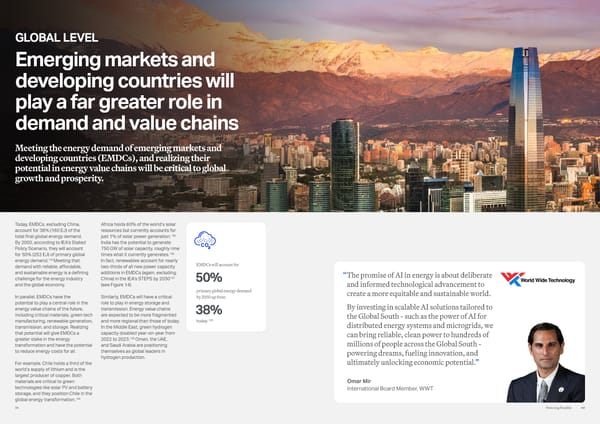Omar Mir International Board Member, WWT “ The promise of AI in energy is about deliberate and informed technological advancement to create a more equitable and sustainable world. By investing in scalable AI solutions tailored to the Global South - such as the power of AI for distributed energy systems and microgrids, we can bring reliable, clean power to hundreds of millions of people across the Global South - powering dreams, fueling innovation, and ultimately unlocking economic potential.” Today, EMDCs, excluding China, account for 38% (160 EJ) of the total final global energy demand. By 2050, according to IEA’s Stated Policy Scenario, they will account for 50% (252 EJ) of primary global energy demand.103 Meeting that demand with reliable, affordable, and sustainable energy is a defining challenge for the energy industry and the global economy. In parallel, EMDCs have the potential to play a central role in the energy value chains of the future, including critical materials, green tech manufacturing, renewable generation, transmission, and storage. Realizing that potential will give EMDCs a greater stake in the energy transformation and have the potential to reduce energy costs for all. For example, Chile holds a third of the world’s supply of lithium and is the largest producer of copper. Both materials are critical to green technologies like solar PV and battery storage, and they position Chile in the global energy transformation.104 Africa holds 60% of the world’s solar resources but currently accounts for just 1% of solar power generation.105 India has the potential to generate 750 GW of solar capacity, roughly nine times what it currently generates.106 In fact, renewables account for nearly two-thirds of all new power capacity additions in EMDCs (again, excluding China) in the IEA’s STEPS by 2030107 (see Figure 14). Similarly, EMDCs will have a critical role to play in energy storage and transmission. Energy value chains are expected to be more fragmented and more regional than those of today. In the Middle East, green hydrogen capacity doubled year-on-year from 2022 to 2023.108 Oman, the UAE, and Saudi Arabia are positioning themselves as global leaders in hydrogen production. Emerging markets and developing countries will play a far greater role in demand and value chains GLOBAL LEVEL Meeting the energy demand of emerging markets and developing countries (EMDCs), and realizing their potential in energy value chains will be critical to global growth and prosperity. EMDCs will account for 50% today 103 38% primary global energy demand by 2050 up from 60 Powering Possible 59
 Powering Possible 2024: AI and Energy for a Sustainable Future Page 30 Page 32
Powering Possible 2024: AI and Energy for a Sustainable Future Page 30 Page 32